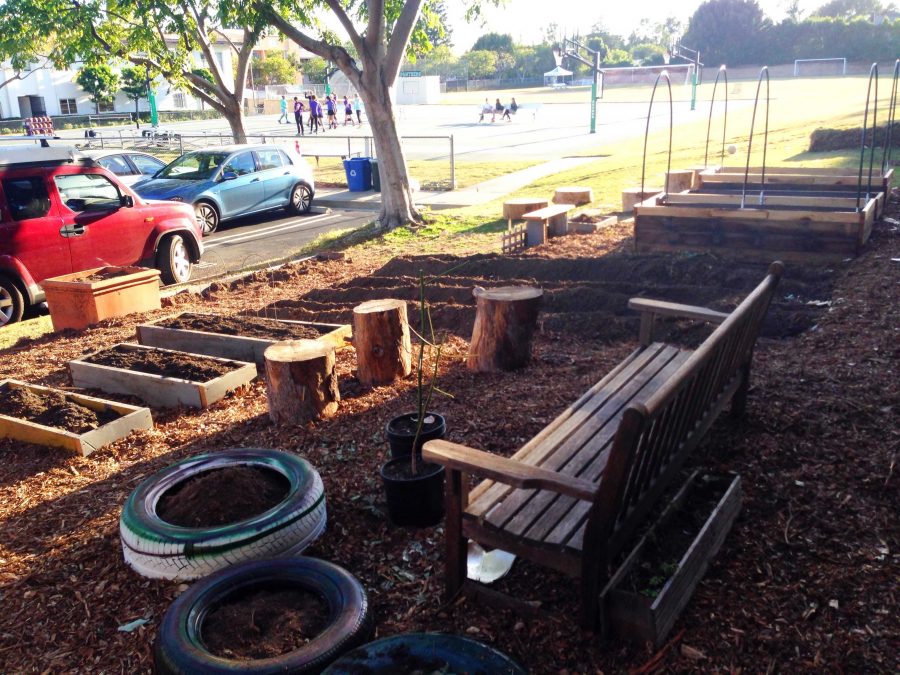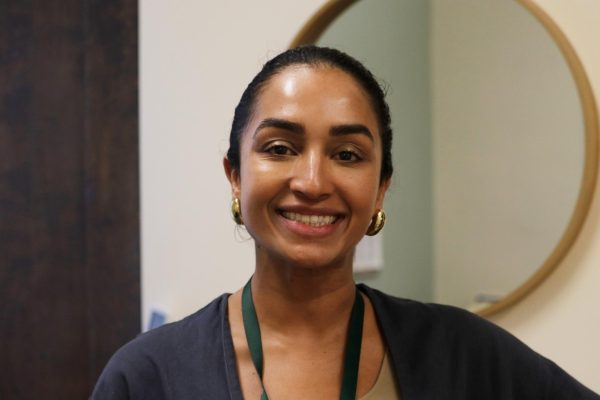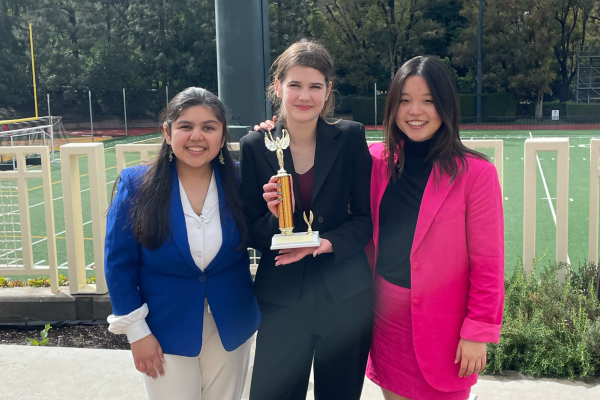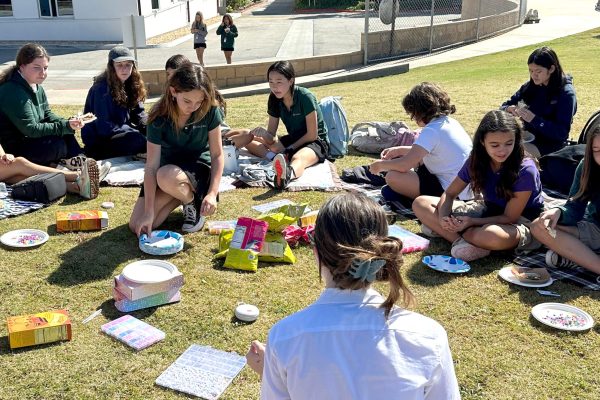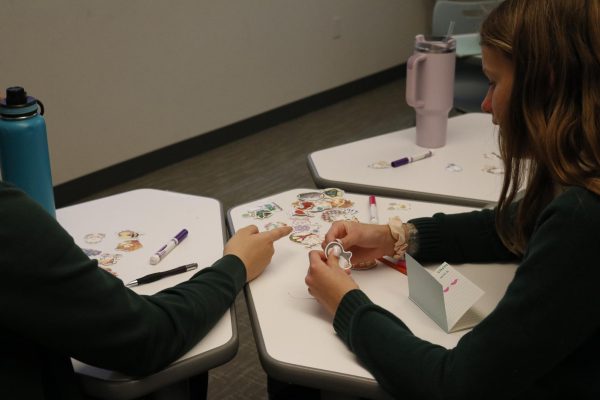Planting the future: Re-envisioned garden pilots sustainable campus
Photo credit: Sydney Stone
The garden sits at the back of the school. The construction process on the renovated garden has just been completed and planting will begin in January.
The stretch of land between the parking lot and the back wall of the school looks very different today than it did just one month ago. Piles of rich compost and organized micro-plots have replaced the dry, dead grass. Once a thoughtful project forgotten by the community, the Archer garden is thriving once again.
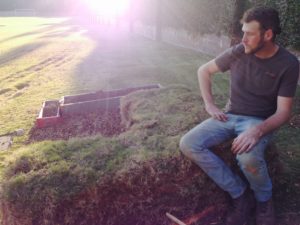
Hirschfeld sits on a couch made of the grass that was torn out to make room for the Archer garden. Hirschfeld began construction on the garden in Oct. 2015.
Science teacher Cushman Gillen leads the sustainability efforts within the school community. His inspiration comes from his Environmental Science class, as well as his UCLA Extension certificate program in sustainability. Through his certificate program, Gillen met Ben Hirschfeld, an urban farmer.
Hirschfeld converted his house into a small production farm in Mar Vista. He has worked on projects for schools and homes in the past, but what makes the Archer project unique is the amount of freedom he has had in the design process.
“When you do garden installs for people’s homes, people are inherently very picky, especially about the property that they own and how it looks and how it produces. Schools want to educate their students on sustainable gardening practices. We want to just inspire you, the student, to be more environmentally conscious in the way that you live your life,” Hirschfeld said.
Archer is very progressive; they’re doing a lot of things that a lot of schools aren’t doing. Maybe it’s because they have the money, maybe they just know that inspiring the youth is going to help to give you direction for what you’re going to do with the rest of your life,” he said. “Archer is a great place to do this kind of work because your minds are ready for this greener, more sustainable, way of life.”
All students are welcome to help with the garden, but Gillen’s sixth-graders and Environmental Science students have taken the lead. Head of School Elizabeth English approved the project in October and designated $5,000 for the construction. Now that the construction of the garden is finished, planting will begin in January.

Gillen’s Environmental Science students prepare the soil before planting begins. These students helped with the garden design process.
“This is the next challenge, we have the physical garden space, but now we need to build a culture, or community, around that space. Sixth-graders may have one little area of the garden, 12th-graders may have one little area of the garden, but the rest of it is really going to be used for the community,” Gillen said.
“Ultimately it should be a space for the community to come together, grow food, learn how the process of growing food works and then from there what do we do with this food,” he said.
Gillen suggested getting student artists involved in the design, starting a farmers market on campus, cooking food with the ingredients from the garden and selling food in the student store.
“I would love for student groups and organizations to run and maintain and figure out what to do and make this garden evolve over time,” he said.
The garden project is just one of Gillen’s many plans for the future of the school. He formed the Archer Council for Sustainability, with seven faculty and staff members. He eventually wants to open up the council for student input. The council’s mission statement reads:
“To create a physical environment that optimizes health and productivity. That can be anything from the health of inside of the building, materials we use in the construction, or providing healthy, sustainable food on campus.”
Despite all of this progress, the garden will be torn apart in the summer of 2017 when construction on the new campus plan begins. However, both Gillen and Hirschfeld agree that this “pilot program” will positively impact the sustainability effort in the long run.
“We’re essentially getting all of the kinks out now so when it comes to putting in a permanent garden later on we’ll know how to do it. We’ll have a network that can facilitate and help run the program once it’s put into the new design,” Gillen said.

Sky Edenfield ’17 and Ava-Rose Beech ’16 work in the garden during their Environmental Science class.
Gillen will also work with the architects of the new building to incorporate gardens into “every nook and cranny around campus.”
Hirschfeld said that it will not be difficult to transition the garden into the new space once construction is completed. The garden is about 98 percent repurposed, made with recycled materials from houses that were being torn down and materials that Archer already had. The door to the toolshed is made from an old bathroom stall door from the school.
“I just want to fill up the space with as much growth and excitement and energy as possible, that way people are more into redoing the garden when the new development happens,” he said. “Gardens don’t have to be these permanent designs, they’re supposed to change and evolve with people and emotions and experiences. That year and a half that the garden is here can change people so significantly that when its torn down, they’re the ones that are here to help build it back up.”
According to Hirschfeld, building a community around the garden is more important than the physical garden space. Gillen agreed, adding, “A school garden is a great way to utilize our space to get students outside, working with their hands, getting connected to the environment,” he said. “If they gain an appreciation for being outside and working in the earth, they may have a better respect for how to protect it later on.”
Hirschfeld hopes that within the next five years every school in the country will have agriculture programs.
“Gardening, working with your hands, working in the dirt, building relationships with your food, will allow for so much more opportunity in the way that you live within the world,” Hirschfeld said as he picked up a handful of mulch and threw it back into the garden.
If you go throughout your life and never experience being outside or working in nature, your likelihood of standing up for the environment later on is less likely.
— Cushman Gillen, Science Teacher
Both Gillen and Hirschfeld emphasized the importance of getting as many people involved in the project as possible.
“We need a whole community to come around and help support this garden, help grow this garden, help maintain it, all aspects of it needs to come from the community. Any ideas, any support, I absolutely welcome and encourage and actually necessitate for the long term future of the garden space,” Gillen said.
“Imagine the affect that Archer could have on all of L.A., on one of the most influential cities in the country, if all of these industry people and bigwigs and CEOs started promoting the stories that their daughters are passionate about,” Hirschfield said.
“They will then spread the word and affect so many more people and create such a significant change that we could never do ever with just building gardens in people’s homes. It has to start with schools.”

Syd Stone graduated in 2016. She became the Voices Editor and the Social Media Manager during the 2013-2014 school year and continued in that position...





![Freshman Milan Earl and sophomore Lucy Kaplan sit with their grandparents at Archer’s annual Grandparents and Special Friends Day Friday, March 15. The event took place over three 75-minute sessions. “[I hope my grandparents] gain an understanding about what I do, Kaplan said, because I know they ask a lot of questions and can sort of see what I do in school and what the experience is like to be here.](https://archeroracle.org/wp-content/uploads/2024/03/grandparents-day-option-2-1200x800.jpg)













































